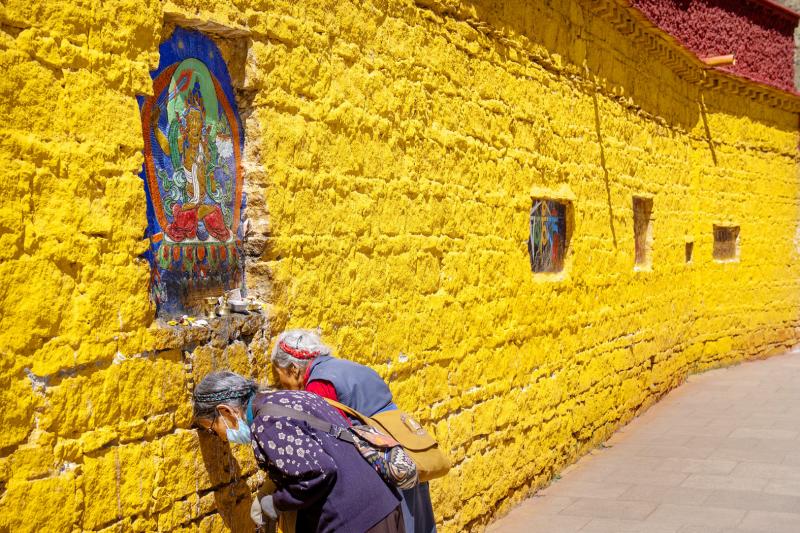The name Tibet conjures up images of snowy peaks, vermillion temples and prayer flags snapping in the Himalayan wind. Those features remain, but the religious and cultural foundations underpinning them appear to be coming unstuck.
Long defined by its Buddhist culture, the region is facing a push for assimilation and political orthodoxy under China’s ruling Communist Party. Tibetans and other minorities are seeing the use of their languages downgraded in schools and old ways of living eroded for the promise of better quality of life through mobile phones, online shopping, higher education and improved health care.
Political conformity is enforced through relentless surveillance of people’s social interactions in actual life and online. Religious practices that once dominated the region have been excised from daily living and the aging Dalai Lama, the spiritual leader of Tibet who has lived in exile since 1959, is portrayed as a figure of scorn, when he’s even acknowledged at all.

Photo: AP
Chinese tourists have flocked to Lhasa, the capital, and it’s environs, despite the high altitude that requires many to rely on canned oxygen. They mix with Tibetans making rare pilgrimages that include devotional laps around Jokhang Temple, the cathedral of Tibetan Buddhism.
A must-go spot for visitors is the stone-paved square at the base of the Potala Palace, the former home of the Dalai Lama and his predecessors that is now a museum. As tourists pose and college graduates use it as a backdrop for class photos, its inert status serves as a reminder of the political issues enveloping Tibet.
Over the centuries, Tibet evolved from a collection of kingdoms to something like a unified state that accepted suzerainty under successive Chinese imperial dynasties that ruled until 1912. Full Chinese control came after the Communist Party took power in 1949 and sent troops to overcome Tibet’s feeble defenses in 1951.
The government says it has brought development to a region long left behind. Critics say the exploitation of Tibet’s natural resources, environmental degradation and an influx of migrants from China’s majority Han ethnic group cannot be sustained.
Lhasa has seen a burst of new construction, nomads have been settled in model villages and the military’s presence has been boosted to assert China’s claim to territory held by India, with whom China last year came to blows over their disputed frontier on Tibet’s southern border.
On a rare government-led tour of Tibet, journalists saw modernization of highways and a railway to the Chinese heartland, schools that teach in Chinese under portraits of Chinese leader Xi Jinping (習近平) and signs of an emerging urban middle class including both Tibetans and Han Chinese.
Under myriad pressures, Tibet’s identity faces possibly the greatest threat in its history. Like the flapping prayer flags, its fate lies in the wind.

As I finally slid into the warm embrace of the hot, clifftop pool, it was a serene moment of reflection. The sound of the river reflected off the cave walls, the white of our camping lights reflected off the dark, shimmering surface of the water, and I reflected on how fortunate I was to be here. After all, the beautiful walk through narrow canyons that had brought us here had been inaccessible for five years — and will be again soon. The day had started at the Huisun Forest Area (惠蓀林場), at the end of Nantou County Route 80, north and east

Specialty sandwiches loaded with the contents of an entire charcuterie board, overflowing with sauces, creams and all manner of creative add-ons, is perhaps one of the biggest global food trends of this year. From London to New York, lines form down the block for mortadella, burrata, pistachio and more stuffed between slices of fresh sourdough, rye or focaccia. To try the trend in Taipei, Munchies Mafia is for sure the spot — could this be the best sandwich in town? Carlos from Spain and Sergio from Mexico opened this spot just seven months ago. The two met working in the

Exceptions to the rule are sometimes revealing. For a brief few years, there was an emerging ideological split between the Democratic Progressive Party (DPP) and Chinese Nationalist Party (KMT) that appeared to be pushing the DPP in a direction that would be considered more liberal, and the KMT more conservative. In the previous column, “The KMT-DPP’s bureaucrat-led developmental state” (Dec. 11, page 12), we examined how Taiwan’s democratic system developed, and how both the two main parties largely accepted a similar consensus on how Taiwan should be run domestically and did not split along the left-right lines more familiar in

A six-episode, behind-the-scenes Disney+ docuseries about Taylor Swift’s Eras Tour and Rian Johnson’s third Knives Out movie, Wake Up Dead Man, are some of the new television, films, music and games headed to a device near you. Also among the streaming offerings worth your time this week: Chip and Joanna Gaines take on a big job revamping a small home in the mountains of Colorado, video gamers can skateboard through hell in Sam Eng’s Skate Story and Rob Reiner gets the band back together for Spinal Tap II: The End Continues. MOVIES ■ Rian Johnson’s third Knives Out movie, Wake Up Dead Man